Wireless identification technologies have revolutionized various industries. It offers efficient tracking, authentication, and data exchange capabilities. Among these technologies, two prominent solutions stand out: Radio Frequency Identification (RFID) and Near Field Communication (NFC). This article delves into a comprehensive comparative analysis of RFID and NFC, exploring their features, applications, advantages, and limitations. By examining these wireless identification technologies sides by side, we aim to provide valuable insights for individuals and businesses seeking the right fit for their identification needs.
RFID vs NFC: What are They?
RFID and NFC are both wireless communication technologies that allow devices to communicate with each other without the need for physical contact. However, there are some key differences between the two technologies. RFID stands for Radio Frequency Identification. NFC stands for Near Field Communication. Here is a more detailed description:
What is RFID?
RFID, short for Radio Frequency Identification, is a wireless technology that uses radio waves to identify and track objects. It uses a microchip inside the tag to store data. RFID systems include RFID labels, readers with antennas, and substrates. RFID tags can classify into active and passive depending on the power availability. Active RFID tags are busy and have their power source inside them to provide energy. Passive RFID tags are passive and provide energy through radio waves transmitted by the reader.
Often, RFID tags are used to track inventory. Manufacturing uses RFID tags as they make products to track products and ship them to customers. The transportation industry uses tags by placing them on objects such as trucks. Scanning the vehicle’s RFID tag captures data information. These data information may include positioning information, delivery time, etc.
RFID chips can also be implanted in animals to track them. Lost animals can scan to get the data information.
RFID can use in a variety of industries. In the retail sector, it also plays a role in theft prevention. The anti-theft function can be achieved by setting up RFID detectors at the entrance and exit of the store. RFID scanners scan customers as they leave the store. If a customer enters the store with an RFID-tagged item, the RFID detector will sound an alarm. RFID tags are also instrumental in the aviation industry. It can help airport staff to identify luggage and cargo.
Related Articles: RFID in Retail: Why Choose It?
What is NFC?
NFC is a technology that evolved from RFID. It exchanges data by having two NFC-enabled devices close to each other. It enables short-range communication between two compatible devices. NFC will be used more in mobile payment, transportation, access control, etc. It can only read things up to 5cm range.
NFC is excellent in the mobile payment space. The large payment platforms we know as Apple Pay, Google Pay, Samsung Pay, and Fitbit Pay are all based on NFC tags to read data. According to UK Finance’s 2021 “UK Payments Market Summary” report, one thing can see. Roughly 17.3 million people signed up for Apple Pay, Google Pay, and Samsung Pay. Nearly 84 percent of them use their mobile payment capabilities.
NFC-enabled devices can also use as various documents. It works as a passport and an electronic ID. It can use for all kinds of cards. For example, they can make into transportation cards, key cards, and login cards. It can also use for social networking. It supports multiple NFC-enabled devices to share photos, videos, files, etc. It can also access multiplayer mobile games.
Related Articles: Why Choose NFC Mobile Payment?
NFC Technology vs RFID Technology: They are Similar
NFC uses a frequency of 13.56 MHz. It happens to be the same as HF RFID among the three operating frequencies of RFID.

The passive mode of NFC is based on the principle of inductive coupling of radio waves. It is similar to the communication principle of RFID.
RFID and NFC are based on transmitting signals between two geographically close objects.
Comparative Analysis: What is The Difference Between NFC and RFID?
RFID and NFC are very similar, but they are also different. RFID is a general term for the contactless exchange of data, and NFC is a subset of RFID. RFID is a method that enables contactless one-way communication over different distances. NFC usually requires user action. It allows two-way communication. They also have the following more apparent differences.
Here’s a table outlining the differences between RFID and NFC:
| Feature | RFID | NFC |
|---|---|---|
| Different Reading Ranges | Can range from a few cm to several meters depending on frequency used | Up to 10 cm |
| Using Different Communication Methods | Uses electromagnetic fields to communicate | Uses near-field communication (NFC) to communicate |
| Frequency Difference | Operates at a wider range of frequencies, including low-frequency, high-frequency, and ultra-high frequency | Operates only at high-frequency |
| Security Strength | Offers good security, but can be vulnerable to hacking and cloning | Offers strong security due to its short-range communication and encryption |
| Communication Technology Differences | Used for tracking and identifying items in supply chain management, inventory management, and asset tracking | Used for mobile payments, access control, data transfer between devices, and more |
RFID vs NFC Range Differences
RFID allows long-distance use, while NFC only supports point-to-point short-distance service. The RFID tag has a reading range of up to 100 meters, and the reader does not need to see it to read it. It also supports reading a large number of tags at once. NFC requires two communication devices a few centimeters apart and a direct site line to the reader. NFC can only read one label at a time.
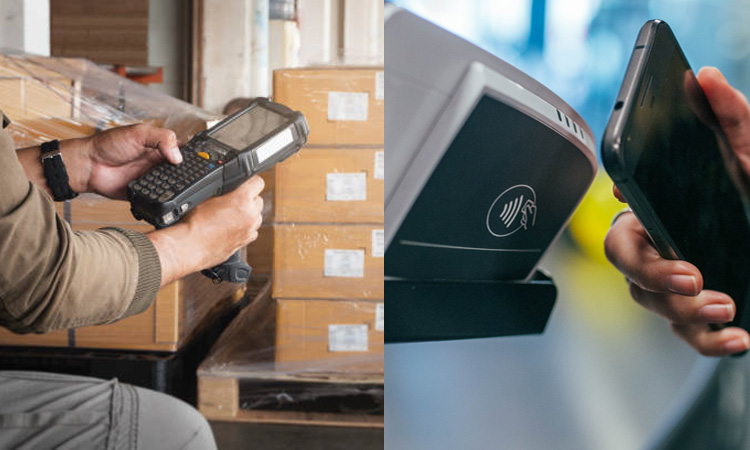
Using Different Communication Methods
RFID only supports radio waves for one-way communication. Generally, the reader receives the radio waves from the tag to read the data. More common is the Passive RFID Tag (Passive RFID System). Through the electromagnetic induction generated by both, the passive RFID tag gets energy from it and activates the microchip inside. The microchip is activated and sends radio waves to the reader, which receives and reads the data information and uploads it to the system. After the electromagnetic induction between the two, the Active RFID Tag (Active RFID System) will actively send out radio waves to the reader.
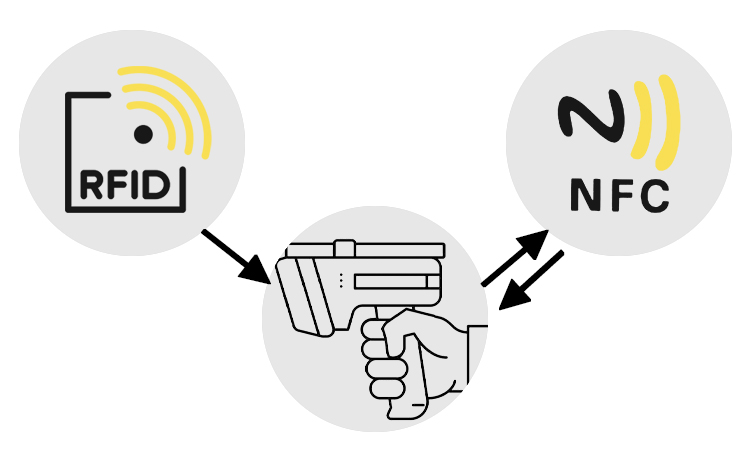
NFC can communicate both one-way and two-way. It can be used as a reader or as a tag. It can support two more complex modes of interaction, including card emulation and peer-to-peer (P2P) data sharing.
RFID vs NFC Frequency Difference
RFID supports operation at several different frequencies. Here we mainly explain low frequency (LF), high frequency (HF), and ultra-high frequency (UHF). The LF RFID frequency band is generally between 30KHz – 300KHz. It only has a reading range of about 10cm. Although its read rate is slower than other technologies, they are well adapted to metal or liquid environments. It is usually used for some short-read-range applications.
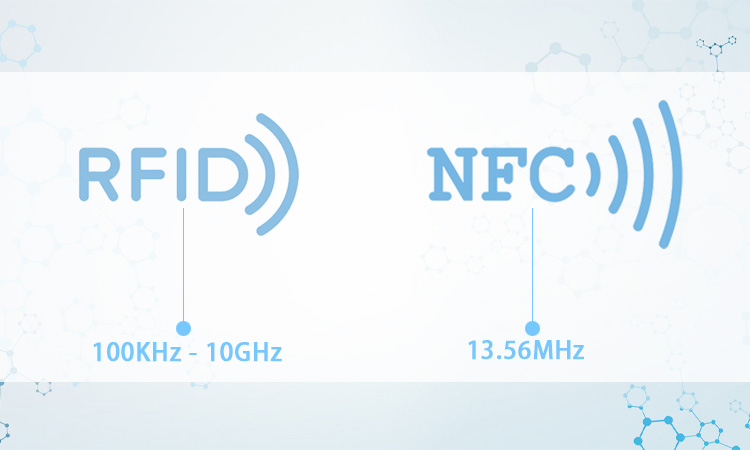
The HF RFID frequency band is between 3MHz – 30MHz. It can read data at distances between 10cm and 1m. For the most part, it works well for payments, ticketing, and data transfer.
The UHF RFID frequency band is between 300MHz – 3GHz. It can achieve a reading distance of up to 12m. In some special cases, it can even be extended to 100m. Its data transfer rate is relatively faster. Because the cost of producing UHF tags is not high, they are mostly used in retail and other industries with high demand.
NFC operates at only one frequency – 13.56MHz. Due to the unique signal attenuation technology in NFC, it has a transmission range of only a few centimeters.
RFID vs NFC Security Strength
The distance has a considerable impact on the security of the data. RFID can be used in many different frequency bands. It has a reasonably long reading range of up to 100m. It means that hackers can easily steal its data information, and the data transmission distance of NFC is only a few centimeters. It may seem to be its disadvantage but also its advantage. It can provide a higher level of security for credit cards. The theft of data information from NFC cards is more complex than RFID credit card sex. Currently, several large payment platforms use NFC technology. They include Apple Pay, Google Pay, and Samsung Pay.

Communication Technology Differences
RFID communication systems include tags, antennas, and readers. All three of them are indispensable. Usually, the information is read and processed by the reader unidirectionally on the label. It is generally used for long-distance communication data transmission.
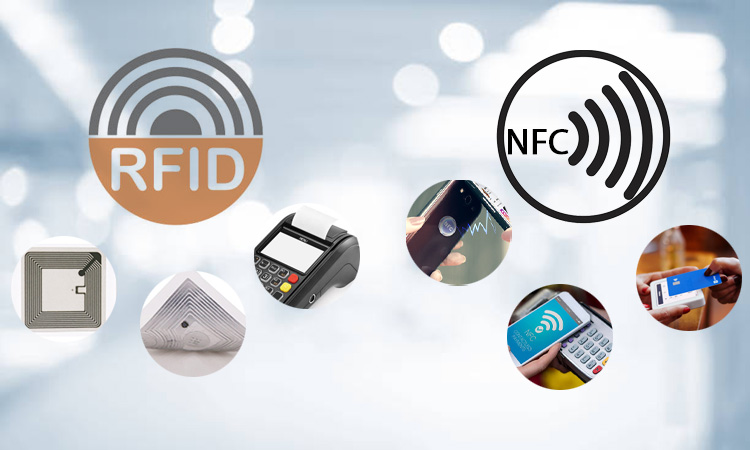
NFC combines the reader, contactless card, and peer-to-peer function into one chip. There are three modes of NFC. They are card mode, peer-to-peer mode (P2P), and reader mode. NFC is equivalent to a contactless card or tag in card mode. It can be used for mobile payments, access control, tickets, etc. It becomes the only electronic identity credential for the user. When it is in P2P mode, NFC is used for data exchange. It is used only as a contactless reader in reader mode. NFC is a private communication method nearby.
Read More: Barcode vs RFID – What are They Difference
NFC vs RFID Card
- Form Factor:
- RFID cards are available in various form factors, including standard credit card sizes, key fobs, wristbands, and stickers. They can also be embedded into other objects, such as passports, ID cards, and product packaging.
- NFC cards are generally smaller in size and commonly found in the form of stickers, key fobs, and wristbands. They are also embedded into smartphones and other devices with NFC capabilities.
- Frequency:
- RFID cards operate at a range of frequencies, from low-frequency (LF) to high-frequency (HF) and ultra-high frequency (UHF). LF and HF RFID cards are commonly used for access control and asset tracking, while UHF RFID cards are used in supply chain management and logistics.
- NFC cards operate at HF (13.56 MHz) and have a shorter range of up to 10 cm (4 inches). NFC cards are used for contactless payment, mobile ticketing, and other applications that require secure and convenient wireless communication.
- Application:
- RFID cards are commonly used for access control, asset tracking, inventory management, and supply chain management. They are also used in payment systems, such as toll collection and public transportation.
- NFC cards are primarily used for contactless payment, mobile ticketing, and access control systems. They are also used in smart home devices and other IoT applications.
- Security:
- Both RFID and NFC cards use encryption technologies to ensure secure communication. However, NFC is considered more secure due to its shorter range, making it less vulnerable to interception or eavesdropping.
- Cost:
- The cost of RFID cards varies depending on the form factor, frequency, and application. Generally, LF and HF RFID cards are less expensive than UHF RFID cards.
- NFC cards are typically more expensive than RFID cards due to their additional capabilities and security features.
NFC versus RFID: Where are They Usually Used?
RFID Tracking
RFID is commonly used for tracking. It is used for applications that require reading over relatively long distances. These applications are manifested in:
- Physical asset tracking
- On-site timing of various competitions
- Inventory management
- Tracking of fast-moving vehicles
- Parcel tracking
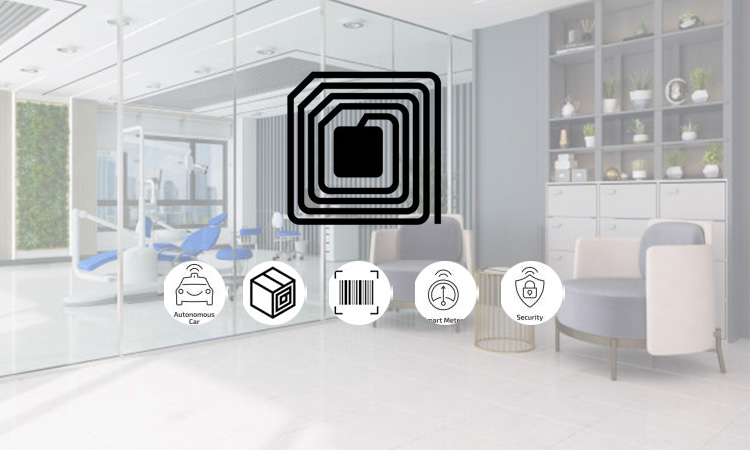
RFID Application Example
RFID applications in the healthcare industry. It uses in a dual interface system for patient monitoring. Usually, patient monitoring devices measure patients’ vital sign parameters. Data such as blood pressure and heart rate. General tags cannot manage these necessary data effectively. These data have exceeded the scope of simple inventory control. These problems can be easily solved by using dynamic RFID tags. It is embodied in the ability to record measurement parameters and input new data into the system.
RFID can create a better community security system. Install readers in the entrances and exits of the community and in the passages where various people may pass. At the same time, RFID electronic tag ID cards are placed on each vehicle that needs to enter the community. The communication line will exchange data with the ground monitoring center. They allow for a more secure security system. The card reader will scan the vehicle when it enters the district. At the same time, the monitoring center will receive relevant information immediately. The monitoring center can know the specific data of the vehicle. This data includes vehicle owner, driving location and time, etc.
RFID provides a better way of cell management.
NFC Communication
NFC is commonly used for communication. It is only suitable for point-to-point proximity applications. These applications are manifested in:
- Mobile payments (contactless payments)
- Sharing information/transferring data
- Simple device pairing
- Store check-in
- After-sales experience
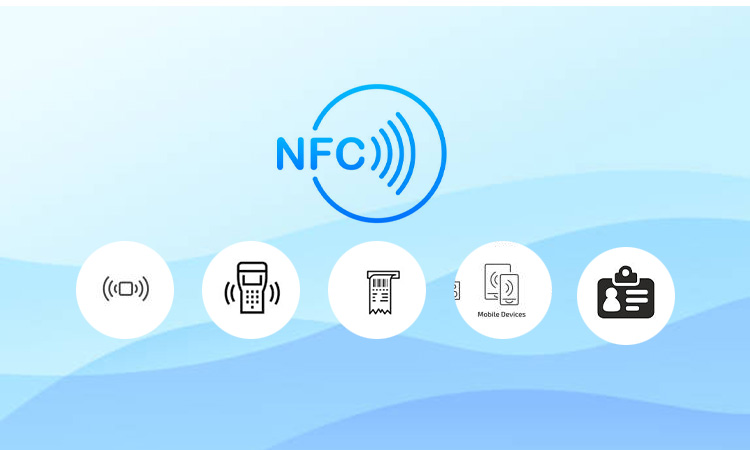
NFC Application Example
NFC is an ideal enterprise application. Most smartphones now come with NFC capability. It can use in a variety of ways. For example, employees can freely carry NFC devices to and from employee parking lots. Employees can use the employee cafeteria and pay for their meals directly. Attendees can wave their compatible phone now in front of the NFC tag to turn it into silent mode before attending a meeting.
NFC has a profound impact on marketing. For example, there are now many posters, ads, and billboards with NFC chips. Users can swipe their NFC-enabled smartphones over them to get product information. Some businesses place NFC tags on promotional locations at the door. Users can access product information using their compatible phones. They can synchronize their logins to social platforms. Users can share with their friends.
The Development of RFID and NFC Technology
If you’ve ever been to a major chain store or restaurant, you’ve probably noticed that they often use RFID technology to track inventory. This is an excellent example of how technology has evolved. In fact, it’s estimated that there are already 35 billion RFID devices in use today – meaning that over 20% of the world’s population has access to this technology.
In addition to tracking inventory, new developments in RFID and NFC technology will allow retailers to know which shelf their product is on and what other products are nearby. This could mean fewer wasted trips to find what you need at the store and more personalized recommendations based on what other items someone has been browsing.
NFC vs RFID: Which is Better?
In summary, we can see that both RFID and NFC have advantages and value. While RFID can read multiple tags long distances, RFID readers are expensive. NFC is embedded directly inside the smartphone, which does not require costly hardware. RFID does not require a straight line of sight to read tags, but NFC can often store more complex data. NFC is also relatively secure because it requires point-to-point proximity to transmit data.
RFID is more suitable for users who have a large number of physical assets. It’s better at long-range recognition. NFC is ideal for users who are extremely sensitive to data security and need to enrich tag data. It is more aimed at communicating with consumer electronic devices. RFID VS NFC, I think we need to look at different business needs to know which is the best.
RFID is a more mature technology compared to NFC. But NFC has a vast world of development. I wonder who will be better in the future, Radio Frequency Identification vs Near Field Communication?
About RFID and NFC Q&A
- Q1: What is the main difference between RFID and NFC?
- A1: RFID is a wireless identification technology that operates over a longer range and is suitable for inventory management and supply chain optimization applications. On the other hand, NFC is a short-range communication technology primarily used for contactless payments, ticketing, and data exchange between nearby devices.
- Q2: Can NFC devices read RFID tags?
- A2: NFC devices can read certain types of RFID tags, primarily those operating at 13.56 MHz, the same frequency NFC uses. However, not all RFID tags are compatible with NFC devices, as RFID encompasses a wider range of frequencies and protocols.
- Q3: Are RFID and NFC technologies secure?
- A3: Both RFID and NFC technologies incorporate security features to ensure secure data transmission. However, it is essential to implement proper authentication mechanisms, encryption protocols, and access control measures to enhance the overall security of RFID and NFC systems.
- Q4: Which technology is more suitable for inventory management?
- A4: RFID technology is widely used in inventory management because it provides real-time tracking, high read range, and extensive data storage capacity. It allows for efficient inventory item monitoring and automation in the reconciliation process. With its shorter range and limited data storage, NFC may not be as suitable for large-scale inventory management applications.
- Q5: Can NFC be used for access control systems?
- A5: Yes, NFC is commonly used for access control systems. NFC-enabled cards or devices can be used for authentication and granting access to restricted areas. The short-range communication of NFC ensures secure and convenient access control. This makes it a popular choice for applications such as office buildings, hotels, and parking lots.
- Q6: How does NFC enable mobile payments?
- A6: NFC technology enables mobile payments by establishing a secure connection between an NFC-enabled smartphone or payment card and a payment terminal. The user simply needs to tap their device or card on the terminal. The necessary payment information is securely transmitted, allowing quick and contactless transactions.
- Q7: Is NFC technology limited to smartphones?
- A7: No, while NFC is commonly associated with smartphones due to their widespread adoption, it is not limited to smartphones alone. Many other devices, such as tablets, smartwatches, and contactless payment cards, also incorporate NFC functionality. This versatility allows for a wide range of NFC-enabled applications beyond smartphones.
- Q8: Can RFID and NFC technologies work together in the same application?
- A8: Yes, RFID and NFC technologies can be integrated to create hybrid solutions. For example, a logistics system may use RFID for long-range tracking and NFC for interaction and authentication at specific checkpoints. The compatibility and integration capabilities would depend on the specific RFID and NFC systems used and the application’s requirements.







